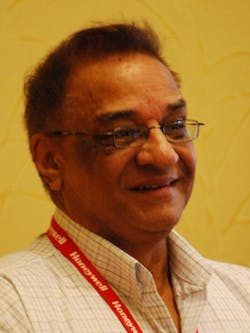Check Out Montague's Google+ profile.
"For some, lifecycle management means maximizing system life, and operating existing system for as long as possible with assured support and future migration paths," began Paul Singh, global blending and oil movements specialist at Chevron in Houston. "For others, it means protecting investment in their assets, and preserving as much of the existing system value as possible. Still others want to future-proof their systems and benefit from latest technology without affecting the continuity of their operations. But overall, control system lifecycle management seeks to provide the greatest return-on-investment over the life of a system."In his presentation today at the Honeywell Users Group Americas 2013 conference in Phoenix, Ariz., Singh reported that Chevron's blending and movement automation (BMA) applications at its large, medium and small refineries generally strive for standardized, online, closed-loop, real-time optimization. This is achieved by employing multi-blend optimization (MBO) scheduling and planning at the enterprise level, which downloads objectives and recipes to blend property controls (BPCs) at the operator stations, which figure out the optimum processes to be carried out, and then runs them on the refinery's distributed control systems (DCSs), blend ratio control (BRC) systems and related instruments and analyzers.
Chevron's DCS and blending applications process from to 50,000 to 800,000 barrels per day, and use a variety of vintage and new systems and equipment. Since 2005, blending optimization at Chevron has been continuously improved through the implementation of new tools such as:
- Multi-product, multi-period, non-linear optimization implementations and upgrades;
- Successive versions of Honeywell blend optimization and automation systems and software; and,
- Migration from NIR and other online analyzers to online Raman analyzers.
"We've also found that as we improve safety and environmental performance, profit improves as well. For example, the difference between the top quarter of performers and the bottom quarter can be more than $1.50 to $2 per barrel, while a performance variation of just 10 cents can add up to about $5 million per year for a typical refinery. And, you can lose $500,000 in one day of doing a blend process wrong, or gain it if you do what's right."
Singh outlined several other trends affecting lifecycle management and BMA, and the needs for them and their application to be as flexible as possible. "Large refineries can't make blends, store them, and analyze them later," he said. "We need to be flexible to reduce downtime between blends. We have one refinery with barely a half hour between blends."
"Also, gone are the days when we made the same product day in and day out. Now, refineries make 50-80 different products. So, we also have to use predictive properties, and account for opt-ins, such as adding ethanol, to save revenue. In the future, we are going to see even more operational complexity, as well as increasing regulations on conventional and biofuels mixes as well as tighter rules for data capture and retention."
Fortunately, Chevron is becoming even more proficient at some of its lifecycle and BMA practices, many of them leveraging the latest Honeywell technology. For example, Singh reported that it completed a BMA320 upgrade about three years ago by implementing redundant C300 controllers on multiple blenders, and adding Experion Blend Controllers (EBC) and Open Blend Property Controllers (OpenBPC).
"We were able to complete one blender cutover in just 16 hours," added Singh. "We migrated from Honeywell Universal Stations to Experion console stations; HPM to Experion PKS C300; BRC v44.3 to Experion Blend Control BMA 320.7; BPC v54.0 to OpenBPC BMA 320.7; and interfaced to a multi-product, multi-period nonlinear optimizer." This particular upgrade produced significant economic benefits, Singh said, including increased uptime and a 50% reduction in deviation from economic optimum.
Singh concluded with several primary best practices for the ongoing lifecycle management journey:
- Always make safety and environment the number one priority.
- Get advanced process control staff involved in the project execution at the earliest stages of the project. They may ask a lot of questions, which operations staff may initially feel is a drag on production, but seeking answers can produce many positive results.
- Resolve all instrumentation, electrical, mechanical, and analyzer issues before control system cutover. Don't assume tasks in other separate disciplines will be completed. Following up can add a little extra cost at the beginning, but can produce big ROIs later.
- Avoid cutover during winter-to-summer transition. Do it during a nice, steady season.
- Provide 24/7 coverage until new system uptime meets expectations.
- And test all interfaces and blend laws thoroughly during factory acceptance test and site acceptance test.








